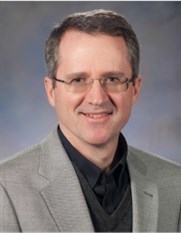 Dr. Timothy Alden Davis, a professor in the Department of Computer Science and Engineering at Texas A&M University, has been named an Association for Computing Machinery (ACM) Fellow. Founded in 1947, ACM is the world's largest association of computing professionals. It serves its membership and the global computing community through cutting edge publications, conferences, and career resources such as its digital library. The Fellow designation is the most prestigious membership grade of the ACM. Davis earned the Fellow designation for his contributions to sparse matrix algorithms and software.
Dr. Timothy Alden Davis, a professor in the Department of Computer Science and Engineering at Texas A&M University, has been named an Association for Computing Machinery (ACM) Fellow. Founded in 1947, ACM is the world's largest association of computing professionals. It serves its membership and the global computing community through cutting edge publications, conferences, and career resources such as its digital library. The Fellow designation is the most prestigious membership grade of the ACM. Davis earned the Fellow designation for his contributions to sparse matrix algorithms and software.
"I've always loved creating algorithms and the code that makes those algorithms work," Davis said. "My brother Jon got me started in high school in 1978. Our high school didn't have a computer, so Jon got me an account on Purdue's mainframe, and a book on Fortran. A year later after punching cards to solve the problems in the book, and fresh out of high school, I was working in the computer room in Purdue's mechanical engineering department, helping college students with their code. I've been helping students create code, and writing my own, ever since."
Davis is recognized as a world leader in algorithmic research for sparse matrix computations. His work combines graph-theoretic methods and numerical techniques to create algorithms for solving problems in computational science that arise across a wide range of applications. He incorporates his novel theory and algorithms into robust library-quality open-source software that is widely used in industry, academia, and government labs.
Davis' graph and sparse matrix algorithms are important to scientific and engineering simulations, social network analysis, computer vision, computer graphics, robotics, and many other domains. The MathWorks relies on his sparse solvers in MATLAB™, a widely-used language and application for technical computing. Every photo in Google StreetView, PhotoTours, and 3D Earth is placed in proper position using his software via Google's Ceres non-linear least squares solver.
The US Geological Survey (USGS) uses his sparse solvers to process images of the Earth, moon, Mercury, and other planetary bodies, cutting their time-to-solution from hours/days down to minutes. Jeff Anderson of the USGS writes that Davis' work "is helping to make accurate cartographic maps of many solar system bodies that will be used for future rover and, hopefully soon, human explorations." Davis' open-source software has been adopted by all major Linux distributions, and is also widely used in open-source packages such as Sandia's Xyce circuit simulator, GIMP, R, Octave, FEniCS, ROS, OpenSLAM.org, Boost, Julia, and Scilab, to name just a few.
Davis' love for algorithms extends into his hobbies. In his free time, he creates mathematical algorithms that translate music into algorithmic art. His methods convert an entire piece of music from its natural domain of time and frequency into a domain of space and color, relying on Fourier transforms, graph theory, sparse matrix methods, and force-directed graph visualization.
"Each image is a translation of an entire song, rather than just a single moment in the song," explained Davis. "The rules are parameterized, and there are more visualizations of any one song than there are particles in the known universe. Part of the artistic process resides in creating thousands and sometimes tens of thousands of images, and selecting the one that best represents the song."
His art portfolio can be found at NotesArtStudio.com.
Davis joined the faculty at Texas A&M in 2014 after 23 years at the University of Florida. He holds doctoral and master's degrees in electrical engineering from the University of Illinois, Urbana-Champaign, and graduated with Distinction with a bachelor's degree in electrical engineering from Purdue University. He is a member of the Parasol Laboratory in the Department of Computer Science and Engineering at Texas A&M, and is Principal Investigator of the Texas A&M CUDA Research Center, named by NVIDIA in June 2014. He became a Fellow of the Society of Industrial and Applied Mathematics (SIAM) in 2013.
The induction of the 2014 ACM Fellows will be held at the ACM annual Awards Banquet in San Francisco on June 20, 2015.
Below on the left is Davis' artistic rendering of "Also Sprach Zarathustra" by Richard Strauss (the theme song for the movie 2001: A Space Odyssey). On the right is Davis' depiction of "Sincere," an electronic piece by M. J. Cole. The mix of complex and regular bass rhythms in "Sincere" translates into an amorphous blue crystalline mesh.
